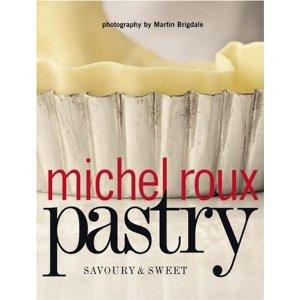 These days you can buy every type of pastry you need ready made in rolls or blocks, so with all that convenience why would you want to get yourself all messy making your own? Satisfaction in craftsmanship is one reason and the other, of course, is that you control the ingredients; a quick read of the boxes of the ready mades is not always very reassuring.
These days you can buy every type of pastry you need ready made in rolls or blocks, so with all that convenience why would you want to get yourself all messy making your own? Satisfaction in craftsmanship is one reason and the other, of course, is that you control the ingredients; a quick read of the boxes of the ready mades is not always very reassuring.
Michel Roux has spent his life up to his elbows in flour and butter. He is one of the few world-famous chefs who is perhaps known for his patisserie skills above all else. He began, as he explains, at the age of 14 with 4 a.m. starts six days a week as a tourier – the person who prepares, rolls and shapes the dough for the day’s work amid a morning mist of airborne flour particles.
Many years later it is a love that has never left him and this book is a distillation of everything he has learnt over a long career, old skills plus new tricks, and he wants to make all his readers proficient in the very ancient craft of pastry making.
It can be complicated of course, so Michel has designed the book with an easy to follow format with all the classic pastries presented in an uncomplicated way and with recipes that make the most of each type.
Chapters are based around individual doughs with step by step technique to guide both the novice and the more experienced cook alike. Michel doesn’t scorn the use of an electric mixer and a dough hook, but he makes it clear that nothing is as satisfying as working exclusively with your hands.
Some pastries are always going to be tricky – he doesn’t pretend otherwise. Puff pastry for example he calls the King of Pastries but says you can make a simple Rough Puff in twenty minutes plus resting and it can be frozen for several weeks, so it’s worth making a batch. The bit about putting a slab of butter in the middle and then rolling and turning always put me off making classic puff pastry but rough puff seems easier, although in my experience I can never keep all the ingredients cold enough – heat is the enemy of many kinds of pastry making, once the butter begins to melt bad things happen.
There are so many kinds of pastry: luscious brioche, classic shortcrust both sweet and savoury and the raised pastry for those pies you can hold in your hand. Why all these can’t be listed at the front instead of having to be searched for in the index at the back is something of a Gallic mystery though. I think also it’s stretching it a bit to put pizza dough recipes in a book called Pastry, but they are clear and useful.
The pictures are great, even if you realise deep down that your efforts aren’t going to turn out half as pretty. The beauty of pies however is that served anywhere but a top class restaurant they satisfy on every level, and even the rough ones look good when brought hot to a hungry table.
This is a book that teaches and inspires too and the thing to do is get your hands floury and give it a go. Even if it all goes poire shaped, you’ll have learned something and practice makes perfect. And, personally, I like some of the recipes so much I am going to cheat occasionally and buy ready made so I can enjoy them a bit more easily. Just don’t tell Michel!
{ISBN:1844006204}
